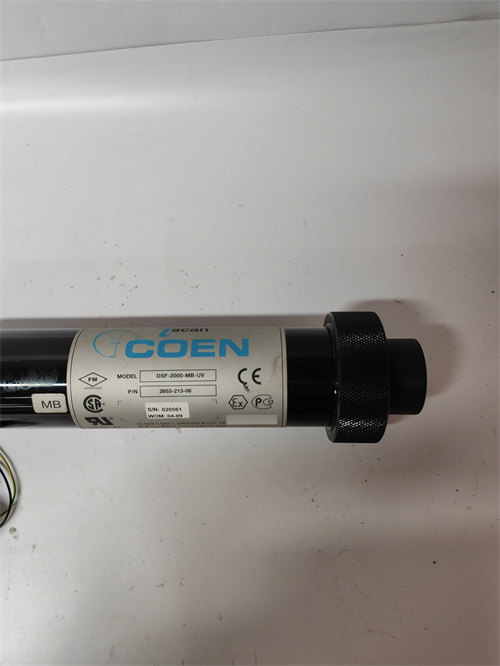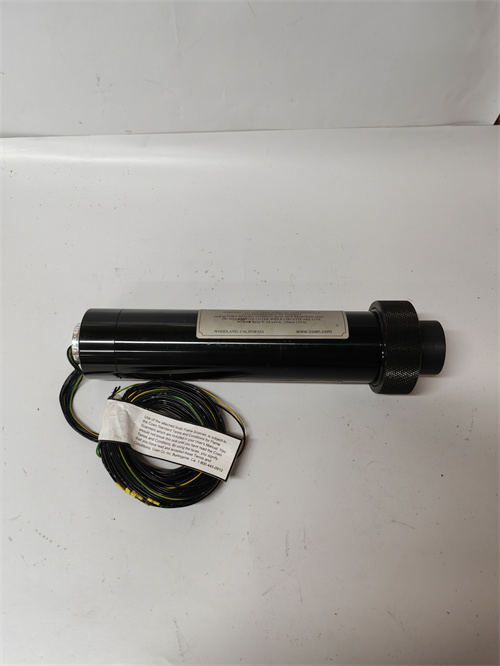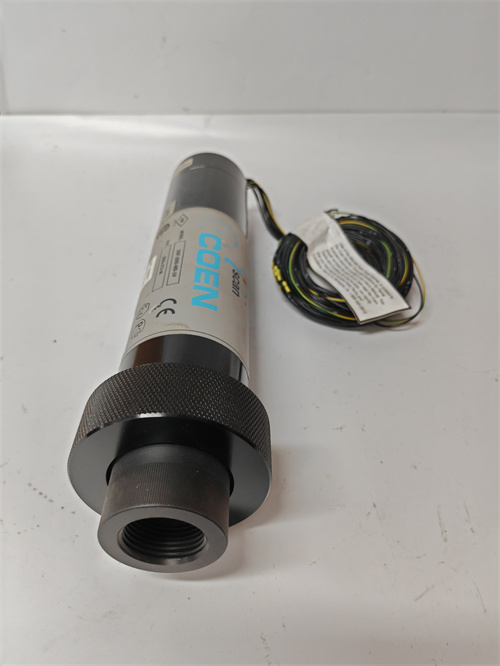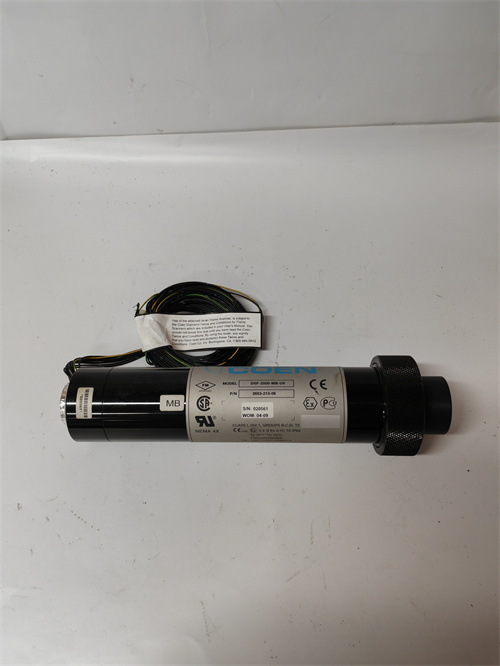الوصف
You’ve provided part numbers for COEN flame scanners, specifically the iSCAN DSF-2000 series. These are critical safety devices in any combustion application, like industrial boilers, furnaces, and burners. Their primary role is to verify the presence of a flame, ensuring safe operation and preventing the dangerous accumulation of unburned fuel.
Let’s break down what each of these numbers signifies:
- COEN iSCAN DSF-2000-UV: This refers to the Coen iSCAN DSF-2000 series flame scanner with a UV (Ultraviolet) detector. UV flame scanners detect the UV radiation emitted by flames. They are generally very fast and can detect flames that might not emit much visible or IR light, like hydrogen fires. The “iSCAN” part signifies that it integrates the scanner and signal processor into one compact unit, eliminating the need for a separate signal processor.
- DSF-2000-MB-UV: This is a more specific model within the DSF-2000 series.
- DSF-2000: Indicates the product family, which uses Digital Signal Processing (DSP) technology for accurate flame detection.
- MB: Likely stands for Multi-Burner or Mainboard, indicating it’s either designed for applications with multiple burners where it needs to discriminate between flames, or it refers to the main circuit board within the scanner. Some sources indicate “MB” refers to the mainboard only, suggesting it might be a component or replacement part.
- UV: Confirms that this version utilizes an Ultraviolet (UV) sensor for flame detection.
- 2653-213-06: This is the Coen part number for the DSF-2000-MB-UV flame scanner. This specific numerical code is used by Coen (now part of Chentronics/Woodward) to identify this particular product.
SEO Optimized Headings:
- COEN iSCAN DSF-2000-UV: Advanced Ultraviolet Flame Scanner for Industrial Safety.
- COEN DSF-2000-MB-UV: Digital Signal Processing Flame Scanner with UV Detection.
- COEN 2653-213-06: Part Number for DSF-2000-MB-UV Flame Safety Device.
- COEN Flame Scanners: Ensuring Safe and Efficient Combustion Operations.
- iSCAN DSF-2000 Series: Integrated Flame Scanners for Burner Management Systems.
- UV Flame Detectors: High-Sensitivity Solutions for Industrial Boilers.
- COEN Burner Management: Reliable Flame Verification in Power Generation.
- DSF-2000-MB-UV Features: Self-Checking and Accurate Flame Discrimination.
- Industrial Flame Safety: Leveraging COEN iSCAN Technology.
- 2653-213-06 Flame Scanner: Critical Component for Process Heating.
Product Summary (Product Detail Card & Search Page Description):
The COEN iSCAN DSF-2000-UV and DSF-2000-MB-UV (Part # 2653-213-06) are advanced ultraviolet (UV) flame scanners designed for industrial combustion applications. Utilizing Digital Signal Processing (DSP) technology, these integrated units provide accurate and reliable flame detection, critical for burner management systems in boilers, furnaces, and other process heaters. They feature self-checking capabilities, robust industrial design, and the ability to discriminate target flames from background radiation, enhancing safety and operational efficiency.
Product Type: Flame Scanner / Flame Detector Detection Method: Ultraviolet (UV) radiation Technology: Digital Signal Processing (DSP) Application: Industrial Boilers, Burners, Furnaces, Heat Treatment Equipment Key Features: Integrated scanner and signal processor, self-checking system, high sensitivity, compact design.
Detailed Product Description
In the demanding world of industrial combustion, safety is paramount. The consequences of an undetected flame failure—such as the accumulation of unburned fuel—can be catastrophic. This is precisely why devices like the COEN iSCAN DSF-2000-UV and DSF-2000-MB-UV (Part # 2653-213-06) are not just useful, but absolutely essential. These aren’t simple light sensors; they are sophisticated, intelligent guardians of your combustion process.
As a combustion engineer, I can tell you that the COEN iSCAN DSF-2000 series represents a significant advancement in flame detection technology. The “iSCAN” in its name signifies an integrated design, meaning the flame scanner itself incorporates the signal processor. This eliminates the need for a separate, bulky signal processing unit, simplifying installation, wiring, and maintenance. At its core, the DSF-2000 leverages Digital Signal Processing (DSP). This allows the scanner to rapidly and accurately analyze the analog signals from its solid-state optical detectors. Instead of just sensing light, it can analyze characteristics like flicker frequency and intensity, enabling it to discriminate between a legitimate flame and other sources of light or hot surfaces within the furnace (like hot refractory). This is crucial in multi-burner applications where a scanner needs to “see” only its own burner’s flame.
The “UV” in DSF-2000-UV and DSF-2000-MB-UV specifies that these models use an ultraviolet (UV) optical detector. UV detectors are highly effective because most flames, including those from natural gas, oil, and even hydrogen, emit UV radiation. UV radiation is typically absorbed quickly by smoke, dust, and steam, which can sometimes be a challenge, but also means it’s less prone to false alarms from incandescent light sources. For applications where a flame must be detected immediately upon ignition or where the flame itself might be difficult to see with other spectrums, a UV scanner is an excellent choice.
From the perspective of a plant operator or maintenance manager, the reliability and safety features of these Coen scanners are invaluable. They often include a self-check system that continuously monitors the integrity of the scanner’s internal components. If a fault is detected (e.g., sensor failure, internal wiring issue), the scanner will enter a fail-safe state, typically de-energizing the flame relay and/or activating a fault relay. This proactive self-diagnosis prevents dangerous conditions from going unnoticed. Furthermore, the compact and lightweight design simplifies positioning, and explosion-proof housings (often FM, UL, and CSA approved) ensure safe operation in hazardous environments. The ability to make adjustments on-screen via user-friendly software (e.g., for sensitivity, flicker frequency, and threshold) saves significant setup time compared to older, manual systems.
Key Features and Core Benefits:
Integrated Design (iSCAN): The scanner and signal processor are combined into a single, compact unit. This reduces wiring complexity, simplifies installation, and eliminates the need for separate signal processor enclosures, saving space and cost.
Digital Signal Processing (DSP) Technology: Utilizes advanced DSP to precisely analyze flame characteristics (e.g., flicker, intensity). This enables superior flame discrimination, allowing the scanner to accurately detect its target flame while ignoring background radiation or hot refractory, especially critical in multi-burner furnaces.
Ultraviolet (UV) Detection: Employs a high-sensitivity solid-state UV detector to sense the UV radiation emitted by flames. UV detection offers fast response times and is effective for a wide range of fuels including gas and oil.
Self-Checking System: Equipped with an internal self-check function that continuously monitors the health of the scanner’s key components. In case of an internal fault, the system triggers a fail-safe condition (e.g., de-energizing the flame relay), enhancing operational safety.
User-Friendly Configuration & Diagnostics: Features a microprocessor-based design with Windows-based software and on-screen displays. This allows for easy adjustments of sensitivity, flicker frequency, and threshold, as well as providing access to system status, burner status, and flame signal data. Some models may include an Electronic Aiming Assist Indicator (EASI) for precise alignment.
Robust and Explosion-Proof Housing: Designed for demanding industrial environments, the scanner typically comes in a durable, lightweight, and explosion-proof housing, often approved by relevant safety agencies (FM, UL, CSA), ensuring reliable operation in hazardous locations.
Technical Specifications (Typical for DSF-2000 series, specifically UV models):
Applications:
COEN iSCAN DSF-2000-UV and DSF-2000-MB-UV flame scanners are indispensable in any industrial facility where safe and efficient combustion of fuels is critical. Their ability to reliably detect and confirm flame presence makes them vital for protecting personnel and assets, as well as optimizing fuel efficiency.
These flame scanners are primarily used in:
- Power Generation Plants: Monitoring flames in large utility boilers (coal, gas, oil-fired) to ensure safe ignition, stable combustion, and shutdown procedures.
- Industrial Boilers and Furnaces: Used across various industries (chemical, petrochemical, pulp & paper, steel, cement) to manage process heat and steam generation.
- Process Heaters: In refineries and chemical plants, ensuring the safe operation of heaters that preheat feedstocks for various processes.
- Waste-to-Energy Facilities: Monitoring combustion in incinerators and waste-fired boilers.
- Cement Kilns: For flame detection in the primary and secondary burners of rotary kilns.
- Heat Treatment Equipment: In specialized furnaces for annealing, tempering, and other thermal processes.
- Any application with a critical burner management system (BMS): Where proving the flame and preventing unburned fuel accumulation is paramount for safety.
Related Products You Might Be Interested In:
To build a comprehensive burner management system (BMS) around the COEN iSCAN DSF-2000 series flame scanners, you’ll typically integrate them with other critical components. Here are some related products and solutions from Coen/Chentronics/Woodward and other leading manufacturers:
- Burner Management Systems (BMS) / Flame Safety Systems: These are the overarching control systems (often PLC or DCS-based) that receive signals from the flame scanners and execute safety interlocks for burner ignition, operation, and shutdown.
- Igniters and Igniter Pilots: Devices used to initiate the main flame, often controlled and monitored in conjunction with flame scanners.
- Fuel Valves and Actuators: Automated valves that control the flow of fuel to the burners, which are opened or closed based on flame scanner feedback and BMS logic.
- Combustion Controllers and PLCs: The central processing units (e.g., from Siemens, Rockwell Automation, ABB) that implement the burner control logic.
- Human-Machine Interfaces (HMIs) / Operator Workstations: Displays and control panels that provide operators with real-time status of burners, flame signals, and alarms.
- Other Flame Scanner Technologies: Depending on the fuel and application, you might also consider Infrared (IR) flame scanners (which detect IR radiation) or Dual-Spectrum (UV/IR) scanners (which combine both for enhanced discrimination). Coen/Chentronics offers these as well (e.g., DSF-2000-IR, DSF-2010-UV/IR).
- Combustion Optimization Systems: Software and hardware that use flame scanner data to fine-tune combustion for efficiency and emissions reduction.







 +86 15340683922
+86 15340683922 +86 15340683922
+86 15340683922